

KNIPPA GAP AREA, UVALDE AND MEDINA, TX
Product Details
- Product Number
- 381991
- Series
- SIR-2013-5149
- Scale
- NO SCALE
- Alternate ID
- SIR-2013-5149
- ISBN
- 978-1-4113-3687-2
- Authors
- ALLAN K CLARK
- Version Date
- 01/01/2013
- Regions
- TX
- Countries
- USA
- Media
- Paper
- Format
- Bound
Additional Details
- Description
-
Abstract
The Edwards aquifer is the primary source of potable water for the San Antonio area in south-central Texas. The Knippa Gap was postulated to channel or restrict flow in the Edwards aquifer in eastern Uvalde County, and its existence was based on a series of numerical simulations of groundwater flow in the aquifer. To better understand the function of the area known as the Knippa Gap as it pertains to its geology and structure, the geologic framework, structure, and hydrogeologic characteristics of the area were evaluated by the U.S. Geological Survey in cooperation with the U.S. Army Corps of Engineers—Fort Worth District.
The principal structural feature in the San Antonio area is the Balcones Fault Zone, which is the result of Miocene age faulting. In Medina County, the faulting of the Balcones Fault Zone has produced a relay-ramp structure that dips to the southwest from the Edwards aquifer recharge zone and extends westward and below land surface from Seco Creek.
Groundwater flow paths in the Edwards aquifer are influenced by faulting and geologic structure. Some faults act as barriers to groundwater flow paths where the aquifer is offset by 50 percent or more and result in flow moving parallel to the fault. The effectiveness of a fault as a barrier to flow changes as the amount of fault displacement changes. The structurally complex area of the Balcones Fault Zone contains relay ramps, which form in extensional fault systems to allow for deformation changes along the fault block. In Medina County, the faulting of the Balcones Fault Zone has produced a relay-ramp structure that dips to the southwest from the Edwards aquifer recharge zone. Groundwater moving down the relay ramp in northern Medina County flows downgradient (downdip) to the structural low (trough) from the northeast to the southwest. In Uvalde County, the beds dip from a structural high known as the Uvalde Salient. This results in groundwater moving from the structural high and downgradient (dip) towards a structural low (trough) to the northeast. These two opposing structural dips result in a subsurface structural low (trough) locally referred to as the Knippa Gap. This trough is located in eastern Uvalde County beneath the towns of Knippa and Sabinal.
By using data that were compiled and collected for this study and previous studies, a revised map was constructed depicting the geologic framework, structure, and hydrogeologic characteristics of the Knippa Gap area in eastern Uvalde and western Medina Counties, Tex. The map also shows the interpreted structural dip directions and interpreted location of a structural low (trough) in the area known as the Knippa Gap.
- Print Date
- 2013
- Height In Inches
- 11.000
- Width In Inches
- 0.250
- Length In Inches
- 8.500
- Two Sided
- Yes
- Pieces
- 1
- Languages
- English




